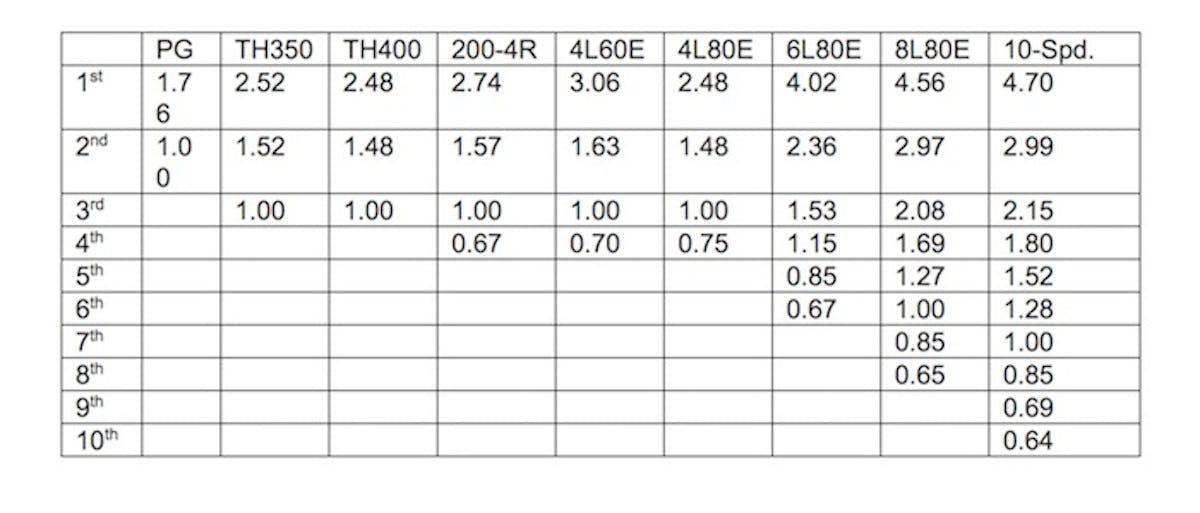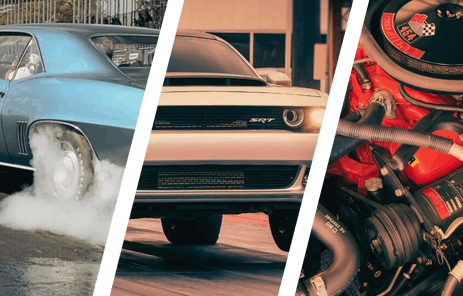
We’re living in a renaissance of the horsepower wars and it’s just plain cool. The technology hasn’t stopped with just engines. Sometimes I peruse the Chevrolet Performance catalog and I find myself acting like a ten year-old leafing through the Sears Christmas catalog. I dream about building a fun Chevelle powered by a Chevrolet Performance Connect & Cruise supercharged LSA engine backed by an overdrive 4L80E.
Then I realized that a single overdrive ratio is now considerably outdated. GM has recently announced a new ten-speed automatic transmission intended for the 2017 ZL1 Camaro. Yikes – ten forward gears including three overdrive ratios! My single overdrive fantasy seems suddenly lackluster. What’s worse is that among all my muscle cars, only one has an automatic with more than three forward gears – and it’s an Art Carr 200-4R.
My latest acquisition is a ’64 El Camino in which I swapped in a carbureted 383ci small-block hooked and a TH-350 because that’s what was laying on the shop floor. This package runs well, but it begs for an overdrive so I’m in the midst of working with my RaceTrans owner Jimmy Galante who is building a 4L60E. I figured I would move up into the world of electronically controlled overdrives. You know – ease my way out of the Paleolithic era.
I knew about the 6L80’s and 6L90’s with six forward gears and also what was until now the latest – the 8L90E trans with eight forward gears and two overdrives. Just in case you’re a data monger like me, I’ve listed all the gear ratios, starting with the Powerglide and working our way to the current ten-speed. This new transmission has a First gear ratio of 4.70:1. I don’t think GM has released the final drive ratios for the ZL-1 Camaro yet, but it will probably be similar to the 8-speed’s 2.73:1 as the “performance” axle ratio.
We’ve come a long way from the days of the two-speed Powerglide. In the ‘60s, a 2.73:1 rear gear was considered a Bonneville gear and your drag car had a 4.56:1 rear gear. Now, the new ten-speed’s First gear is 4.70:1 and the rear gear is probably going to around 2.73:1 or taller. The math still works the same. Multiply the trans First gear times the rear gear ration for overall First gear. This means the new Camaro will accelerate in First gear as if it had a 4.70:1 rear gear and a 2.73:1 First gear trans. Then it gets better.
The whole idea with increasing the number of forward gears is to improve acceleration by reducing the rpm drop between gears. To use an extreme example, the two-speed Powerglide uses a1.76:1 First gear ratio followed by 1:1. If we take out the slippage of the converter, shifting at 6,200 into high gear creates a huge rpm drop to 3,523 rpm! Now let’s look at the new GM ten-speed. At the same 6,200 rpm shift point, a shift from Third to Fourth gear (a 16 percent ratio change) only drops the revs to 5,208 (again ignoring converter slippage). That’s going to really improve acceleration.
This effect is impressive especially if we compare a Powerglide to the new ten-speed. This is a really unfair comparison – but it illustrates the advantage of technology. I decided to use my copy of the Quarter, Pro drag strip program and chose a small displacement motor with not as much torque because this combo should really benefit from the ten-speed’s tighter gear spread.
I set up the test with a Powerglide in my ’66 Chevelle powered by a 430 hp normally aspirated 5.3L LS engine with 4.70:1 rear gears. Then for the comparison I added the ten-speed with a 2.73:1 rear gear with no other changes. The simulation only allowed me to plug in the first five gears, peaking at 6,170 rpm in Fifth gear at the end of the 1,320.
The Powerglide combo ran 13.07 at 109 mph with a 2.06 60-foot time. Adding the ten-speed’s tighter gear spread made a huge difference with the simulation estimating a 12.10 at 112.90 mph. That’s an improvement in e.t. of nearly one second yet only 3 mph. This really illustrates the advantage of keeping the engine rpm within its power band. The engine is making the same power, but we’re using that power much more efficiently to run quicker. The ten-speed is an attempt to move toward what is often referred to as a continuously variable transmission (CVT) much like what snowmobiles use.
These ten-speeds are incredibly complex and also heavier. I don’t know the weight for this latest gearbox, but the 6L90E weighs around 230 pounds without a converter. So it’s likely the ten-speed will weigh around 250 pounds or so plus the converter. This compares to a TH350 trans that weighs in at a svelte 130 pounds (all without converter). And those lockup converters are also heavy.
So there you have it, a very short introduction to 21st century transmission technology. I’ve moved up one overdrive with my 4L60E – but that still leaves me six speeds short! But for today, four speeds will have to suffice. But tomorrow, who knows, I might be yearning for ten.
GM Automatic Transmission Gear Ratios
You might also like
SEMA 2024: Richmond RGI-5 Shifts The Game
The Richmond RGI-5 is a revolutionary internal rail-shifted transmission that redefines what's possible in manual shifting. The RGI-5 combines sleek internal rail-shifting with legendary Richmond strength.



